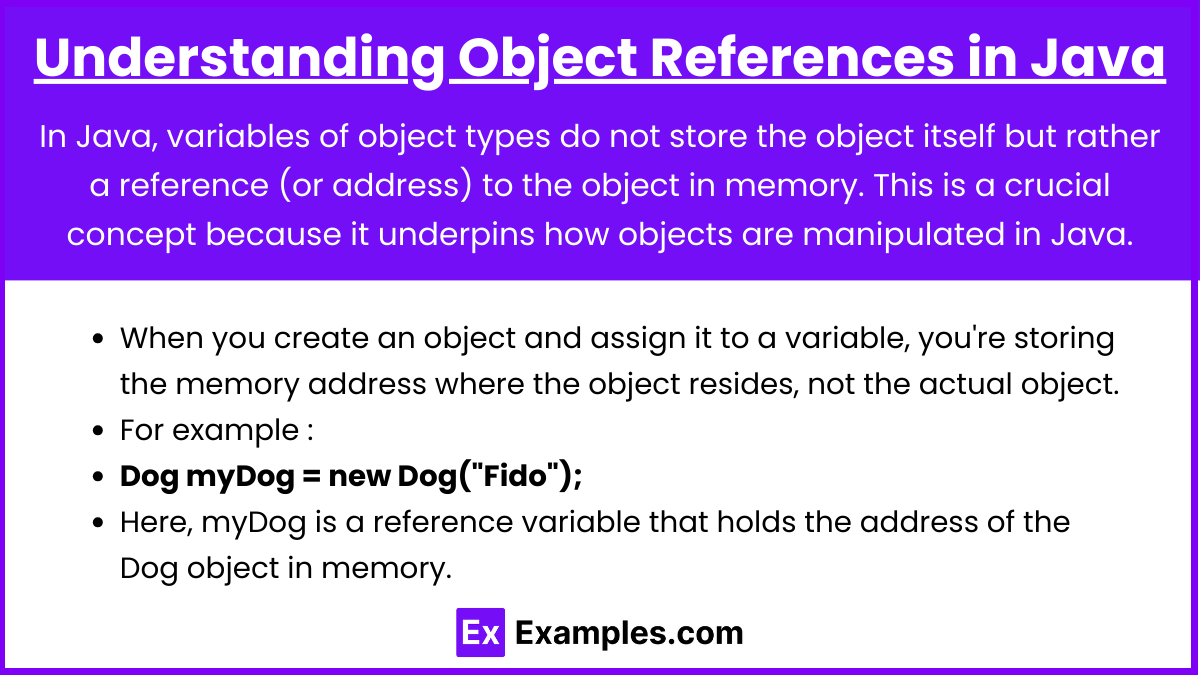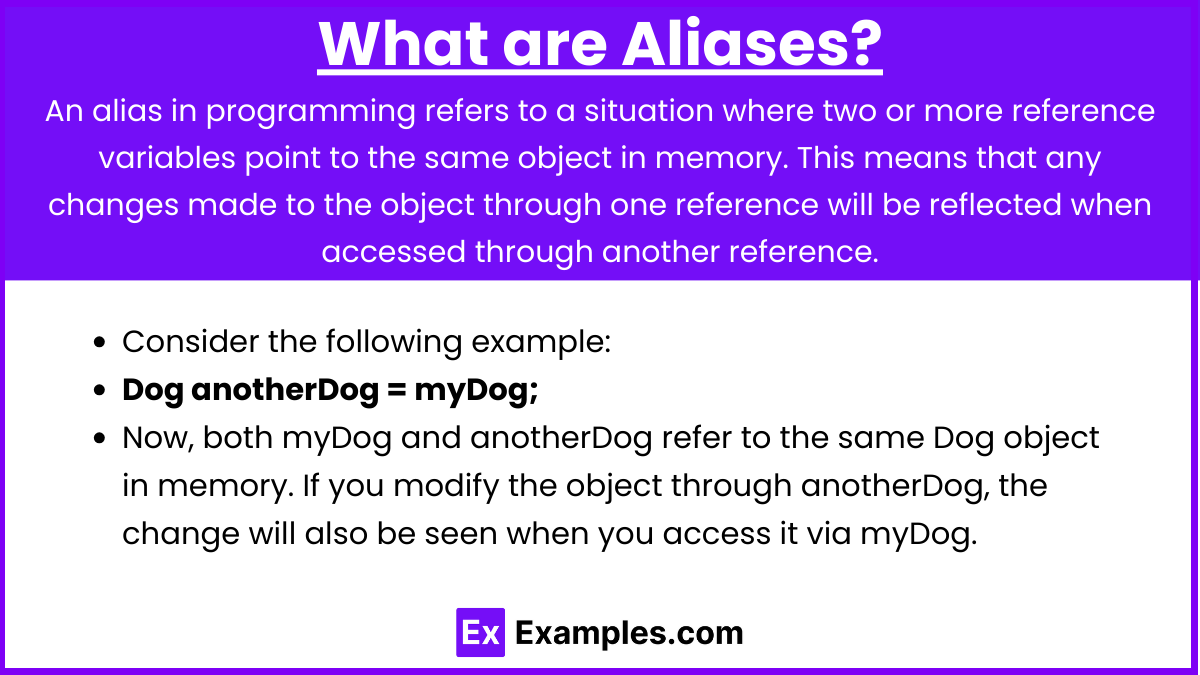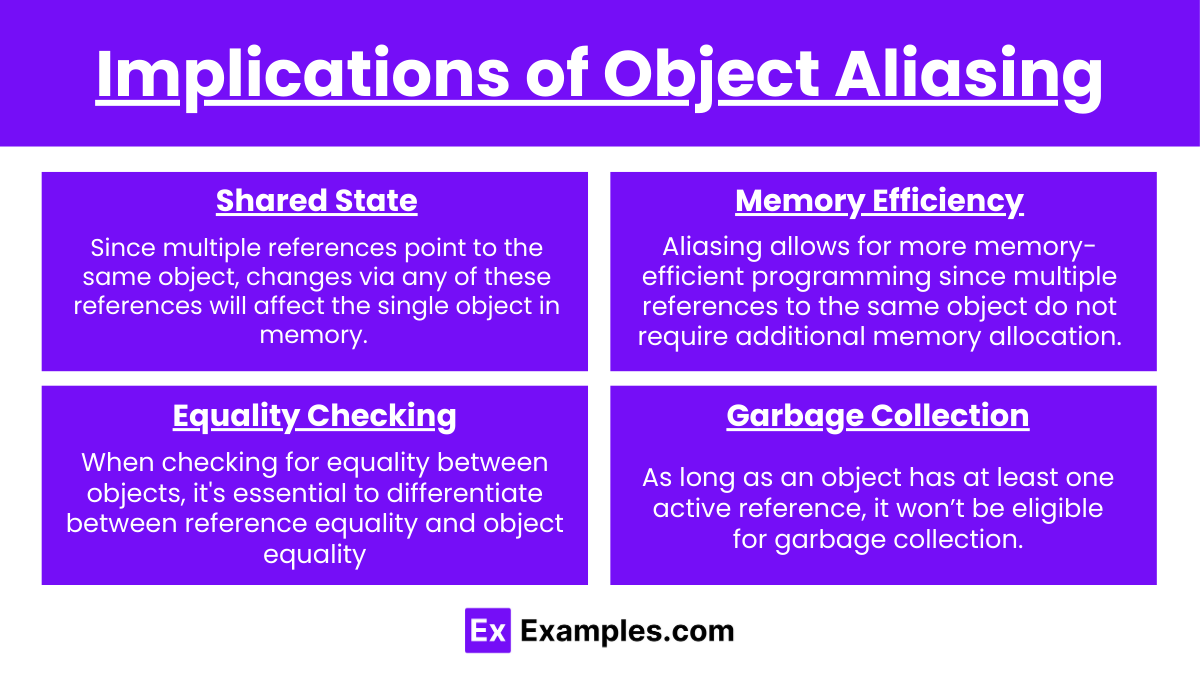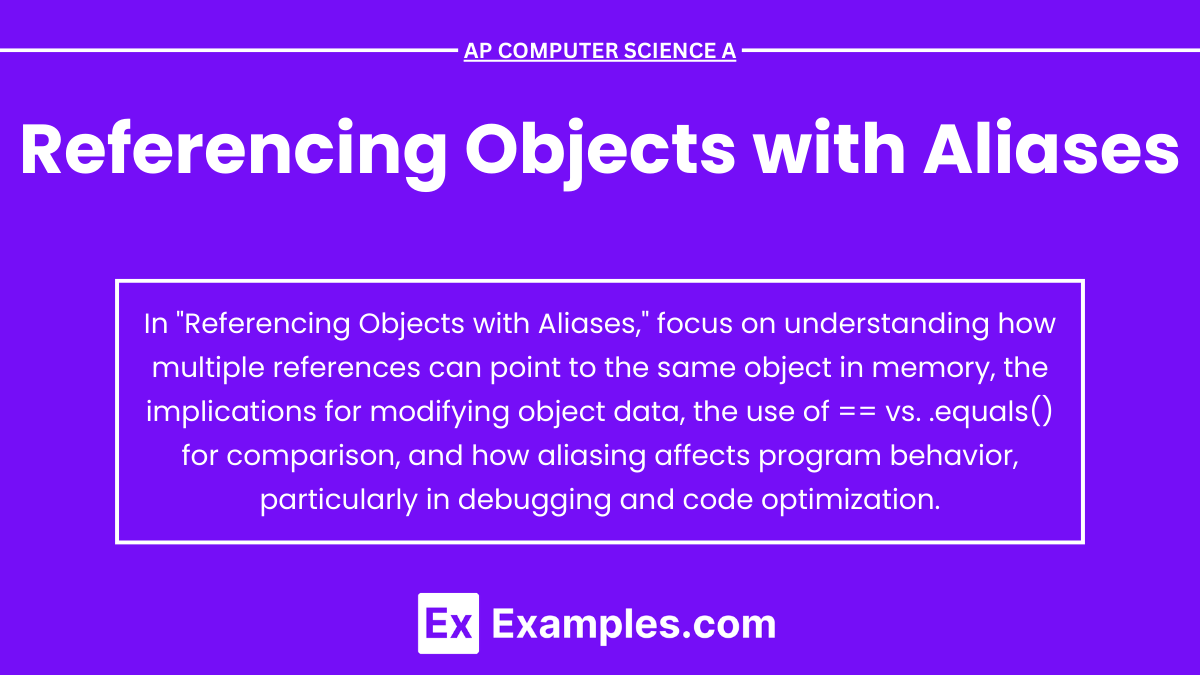In AP Computer Science A, understanding “Referencing Objects with Aliases” is crucial for mastering object manipulation in Java. When two or more reference variables point to the same object in memory, they are considered aliases. Any modification made through one alias directly impacts the object, affecting all other aliases. This concept is essential for efficient memory management and avoiding unintended side effects in programs. Grasping how aliases work enhances your ability to write robust, error-free code in complex applications.
Learning Objectives
For the topic “Referencing Objects with Aliases” in AP Computer Science A, you should focus on understanding how object references work in Java, including how multiple references can point to the same object in memory. Learn to identify and manage the implications of aliasing, such as shared state, reference equality versus object equality, and potential side effects. Grasp the significance of these concepts in writing efficient and error-free code, especially when passing objects between methods or manipulating complex data structures like arrays.
Understanding Object References in Java

In Java, variables of object types do not store the object itself but rather a reference (or address) to the object in memory. This is a crucial concept because it underpins how objects are manipulated in Java.
When you create an object and assign it to a variable, you’re storing the memory address where the object resides, not the actual object. For example:
Dog myDog = new Dog("Fido");Here, myDog is a reference variable that holds the address of the Dog object in memory.
What are Aliases?

An alias in programming refers to a situation where two or more reference variables point to the same object in memory. This means that any changes made to the object through one reference will be reflected when accessed through another reference.
Consider the following example:
Dog anotherDog = myDog;Now, both myDog and anotherDog refer to the same Dog object in memory. If you modify the object through anotherDog, the change will also be seen when you access it via myDog.
Implications of Object Aliasing

Aliasing can have significant implications on your program:
- Shared State: Since multiple references point to the same object, changes via any of these references will affect the single object in memory. This can lead to unintended side effects if you’re not careful, as you might inadvertently change the state of the object through one alias while expecting it to remain unchanged in another context.
- Memory Efficiency: Aliasing allows for more memory-efficient programming since multiple references to the same object do not require additional memory allocation. However, this can also lead to potential risks if the shared object is modified unexpectedly.
- Equality Checking: When checking for equality between objects, it’s essential to differentiate between reference equality and object equality:
- Reference Equality (==) checks whether two references point to the same memory location.
- Object Equality (equals()) checks whether two objects are logically equivalent.
- Garbage Collection: As long as an object has at least one active reference, it won’t be eligible for garbage collection. Aliasing can keep an object alive in memory even when one reference is discarded, as long as other references to the object exist.
Examples
Example 1: Mutating a List through Multiple References
Consider a situation where you have a List<String> object, and you assign it to another reference variable. Any changes made through one reference, such as adding or removing elements, will be reflected in the other reference as both point to the same list in memory. For instance:
List<String> list1 = new ArrayList<>();
list1.add("Hello");
List<String> list2 = list1;
list2.add("World");Both ‘ list1 ‘ and ‘ list2 ‘ will now contain the elements “Hello” and “World”.
Example 2: Updating an Object’s Field
Suppose you have a Person class with a field name. If you create two references to the same Person object, updating the name field through one reference will affect the object regardless of which reference is used to access it:
Person person1 = new Person("Alice");
Person person2 = person1;
person2.name = "Bob";After this change, accessing name via ‘ person1 ‘ will yield “Bob” because both ‘ person1 ‘ and ‘ person2 ‘ refer to the same Person object.
Example 3: Sharing an Object Between Methods
If an object is passed to a method, and the method modifies the object, the changes will persist outside the method because the object reference is passed by value. For example:
void updateBoxSize(Box box, int newSize) {
box.size = newSize;
}
Box myBox = new Box(5);
updateBoxSize(myBox, 10);After calling ‘ updateBoxSize ‘, ‘ myBox.size ‘ will be 10, demonstrating that the method altered the same object in memory.
Example 4: Aliasing with Arrays
Arrays in Java are objects, so when you assign one array reference to another, both references point to the same array in memory. Changing an element through one reference affects the array for all references:
int[] array1 = {1, 2, 3};
int[] array2 = array1;
array2[0] = 10;Here, ‘ array1[0] ‘ will be ‘ 10 ‘ because ‘ array1 ‘ and ‘ array2 ‘ are aliases for the same array.
Example 5: Chaining Aliases
You can create multiple aliases by chaining references. If you create a new reference from an existing alias and then modify the object, all previous references reflect the change. For instance:
Box box1 = new Box(5);
Box box2 = box1;
Box box3 = box2;
box3.size = 15;In this case, both box1 and box2 will see box1.size as 15, as all references (box1, box2, box3) are aliases pointing to the same Box object.
Multiple Choice Questions
Question 1
Given the following code snippet:
class Book {
String title;
Book(String t) { title = t; }
}
Book book1 = new Book("Java Programming");
Book book2 = book1;
book2.title = "Advanced Java";What will be the output of System.out.println(book1.title);?
A) ‘ “Java Programming” ‘
B) ‘ “Advanced Java” ‘
C) ‘ null ‘
D) ‘ A compilation error will occur. ‘
Answer:
Correct Answer: B) ‘ “Advanced Java” ‘
Explanation: In this example, ‘ book1 ‘ and ‘ book2 ‘ are references to the same ‘ Book ‘ object in memory. When the title is updated through book2, it modifies the single ‘ Book ‘ object that both book1 and book2 reference. Therefore, when book1.title is printed, it reflects the updated title “Advanced Java”.
Question 2
Consider the following code:
int[] arr1 = {1, 2, 3};
int[] arr2 = arr1;
arr2[0] = 10;What is the value of arr1[0] after the above code executes?
A) 1
B) 10
C) 0
D) ArrayIndexOutOfBoundsException is thrown.
Answer:
Correct Answer: B) 10
Explanation:
Arrays in Java are objects, and when arr2 is assigned to arr1, both arr1 and arr2 reference the same array object in memory. Modifying an element of the array through arr2 changes the array itself. Therefore, ‘ arr1[0] ‘ is now 10, the value that was set through ‘ arr2[0] ‘.
Question 3
What is true about the following code?
Car car1 = new Car("Tesla");
Car car2 = car1;
car1 = new Car("Ford");A) ‘ car2 ‘ now references the “Ford” car.
B) ‘ car1 ‘ and ‘ car2 ‘ both reference the “Ford” car.
C) ‘ car2 ‘ still references the “Tesla” car.
D) ‘ car1 ‘ is null.
Answer:
Correct Answer: C) car2 still references the “Tesla” car.
Explanation:
Initially, ‘ car1 ‘ and ‘ car2 ‘ are both referencing the same ‘ Car ‘ object, the “Tesla.” However, when ‘ car1 ‘ is reassigned to a new Car object with the value “Ford,” this does not affect ‘ car2 ‘. car2 continues to reference the original “Tesla” car, while car1 now references a new “Ford” car object. Therefore, car2 still holds the reference to the “Tesla” car.


